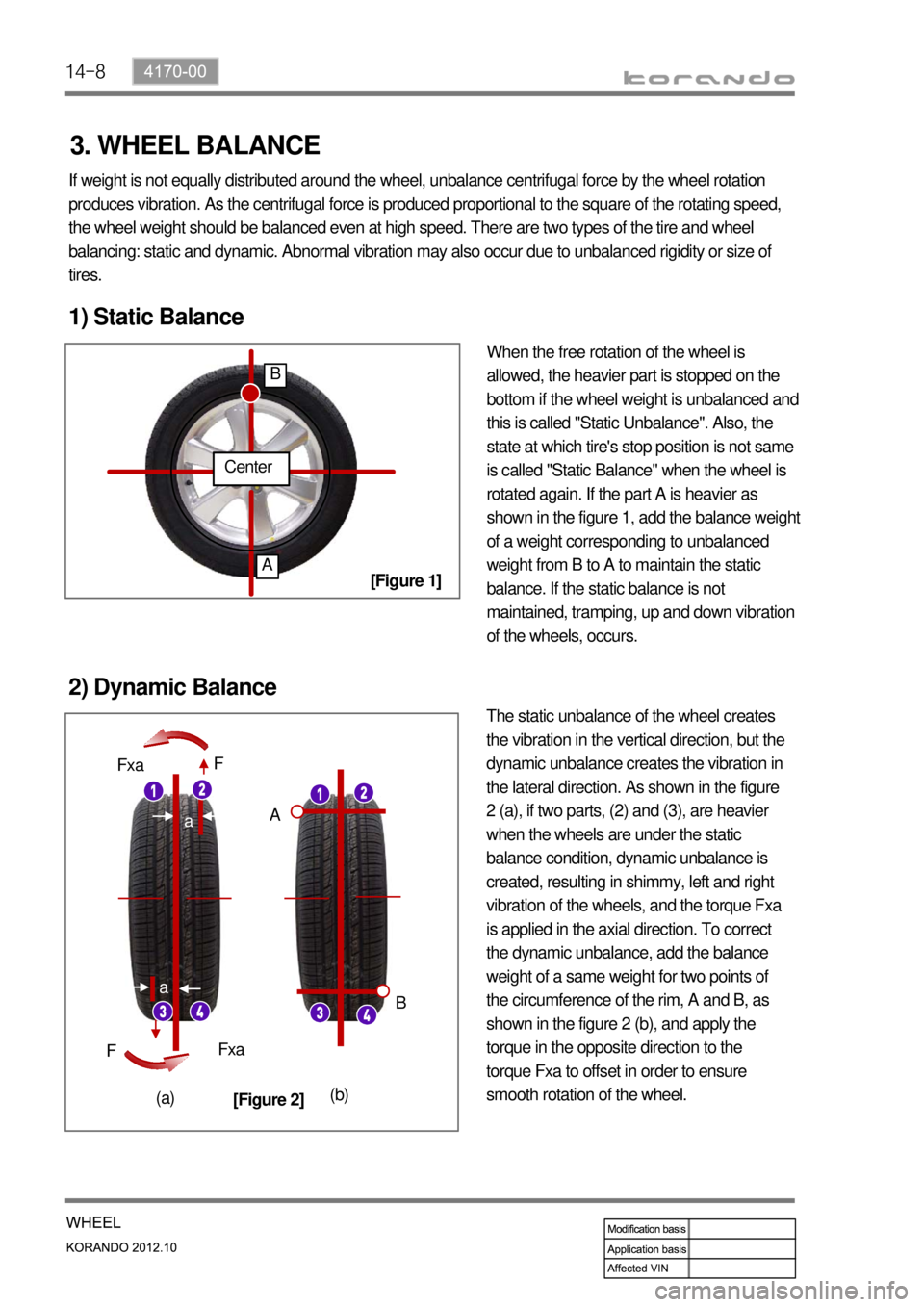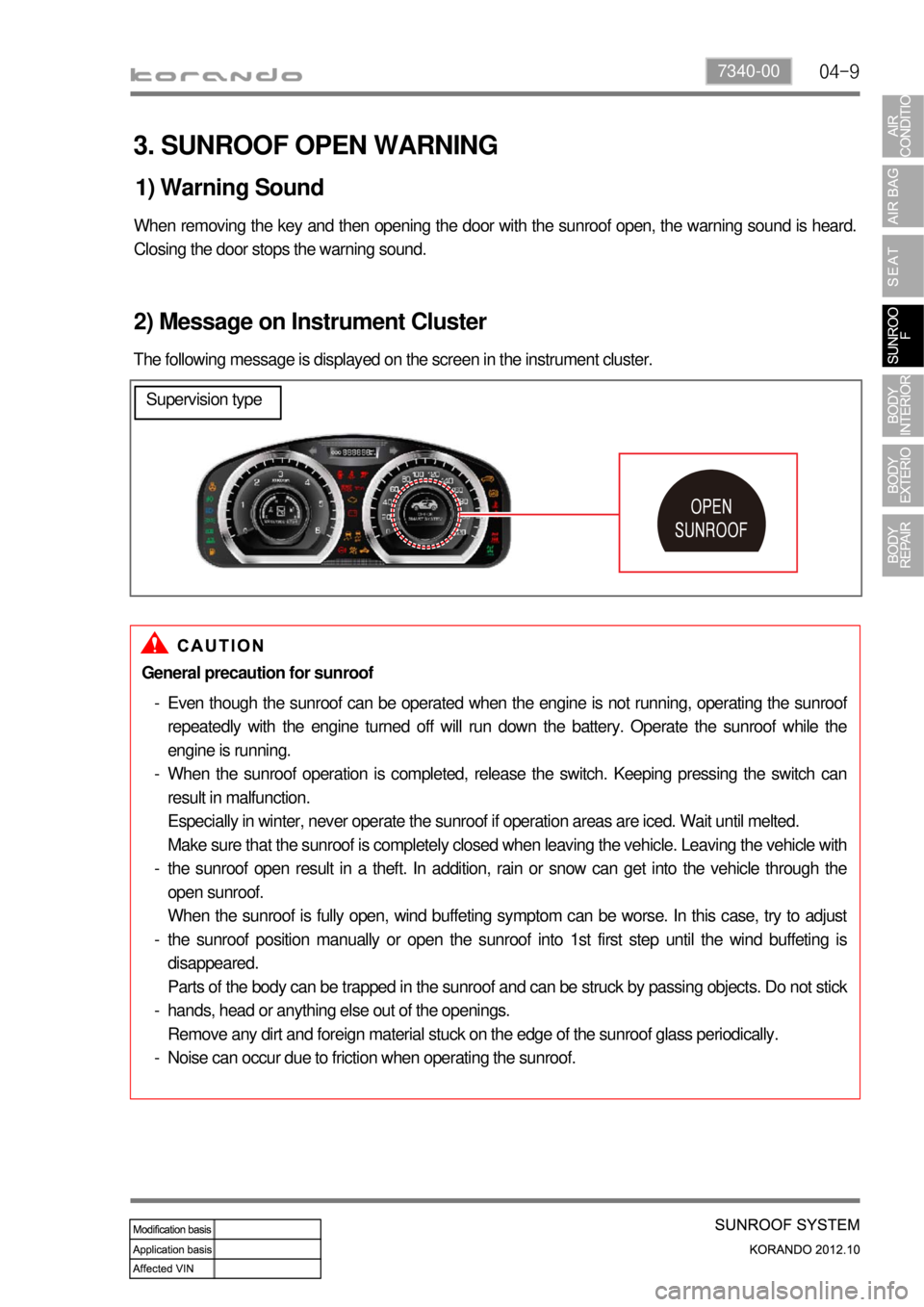ESP SSANGYONG KORANDO 2012 Owners Manual
[x] Cancel search | Manufacturer: SSANGYONG, Model Year: 2012, Model line: KORANDO, Model: SSANGYONG KORANDO 2012Pages: 1082, PDF Size: 96.1 MB
Page 979 of 1082

11-270000-00
7. CIRCUIT DIAGRAM
Wheel speed sensor, Stop lamp switch, Self diagnostic connector, Warning lamp (ABS/ESP) ▶
Page 996 of 1082

14-8
If weight is not equally distributed around the wheel, unbalance centrifugal force by the wheel rotation
produces vibration. As the centrifugal force is produced proportional to the square of the rotating speed,
the wheel weight should be balanced even at high speed. There are two types of the tire and wheel
balancing: static and dynamic. Abnormal vibration may also occur due to unbalanced rigidity or size of
tires.
1) Static Balance
When the free rotation of the wheel is
allowed, the heavier part is stopped on the
bottom if the wheel weight is unbalanced and
this is called "Static Unbalance". Also, the
state at which tire's stop position is not same
is called "Static Balance" when the wheel is
rotated again. If the part A is heavier as
shown in the figure 1, add the balance weight
of a weight corresponding to unbalanced
weight from B to A to maintain the static
balance. If the static balance is not
maintained, tramping, up and down vibration
of the wheels, occurs.
2) Dynamic Balance
The static unbalance of the wheel creates
the vibration in the vertical direction, but the
dynamic unbalance creates the vibration in
the lateral direction. As shown in the figure
2 (a), if two parts, (2) and (3), are heavier
when the wheels are under the static
balance condition, dynamic unbalance is
created, resulting in shimmy, left and right
vibration of the wheels, and the torque Fxa
is applied in the axial direction. To correct
the dynamic unbalance, add the balance
weight of a same weight for two points of
the circumference of the rim, A and B, as
shown in the figure 2 (b), and apply the
torque in the opposite direction to the
torque Fxa to offset in order to ensure
smooth rotation of the wheel.
Center
A
B
a
a
Fxa
Fxa F
F
A
B
(a)(b)
[Figure 1]
[Figure 2]
3. WHEEL BALANCE
Page 1024 of 1082

02-8
4. CAUTIONS FOR AIR BAG OPERATION
When there is any deployed air bag (including curtain air bag and seat belt pretensioner), the air
bag unit should be replaced. Any DTC (Diagnostic Trouble Code) for the air bag unit should not
be cleared since it has status data when the air bag deployed.
Note that the used components related to the air bag system, especially the air bag unit, should
be packed in an air tight container to prevent any damage.
Do not connect a tester probe to the air bag connector or air bag body to measure the supply
voltage or resistance. The detonator may explode due to a sudden extra power supplied by the
tester.
Before removing or installing any air bag related components, disconnect the negative battery
cable. 1.
2.
3.
4. When turning on the ignition switch, the air bag warning lamp is illuminated for about 6 sec. and then
goes off.
If the air bag warning lamp comes on or does not go off while the vehicle is driven, the air bag system is
faulty.
Page 1046 of 1082

04-97340-00
3. SUNROOF OPEN WARNING
1) Warning Sound
When removing the key and then opening the door with the sunroof open, the warning sound is heard.
Closing the door stops the warning sound.
2) Message on Instrument Cluster
The following message is displayed on the screen in the instrument cluster.
General precaution for sunroof
Even though the sunroof can be operated when the engine is not running, operating the sunroo
f
repeatedly with the engine turned off will run down the battery. Operate the sunroof while the
engine is running.
When the sunroof operation is completed, release the switch. Keeping pressing the switch can
result in malfunction.
Especially in winter, never operate the sunroof if operation areas are iced. Wait until melted.
Make sure that the sunroof is completely closed when leaving the vehicle. Leaving the vehicle with
the sunroof open result in a theft. In addition, rain or snow can get into the vehicle through the
open sunroof.
When the sunroof is fully open, wind buffeting symptom can be worse. In this case, try to adjust
the sunroof position manually or open the sunroof into 1st first step until the wind buffeting is
disappeared.
Parts of the body can be trapped in the sunroof and can be struck by passing objects. Do not stick
hands, head or anything else out of the openings.
Remove any dirt and foreign material stuck on the edge of the sunroof glass periodically.
Noise can occur due to friction when operating the sunroof. -
-
-
-
-
-
Supervision type